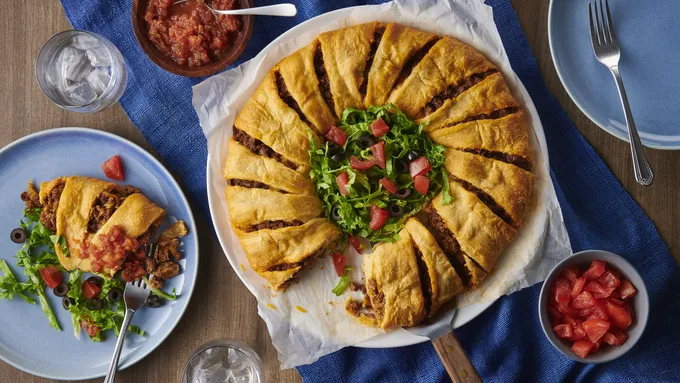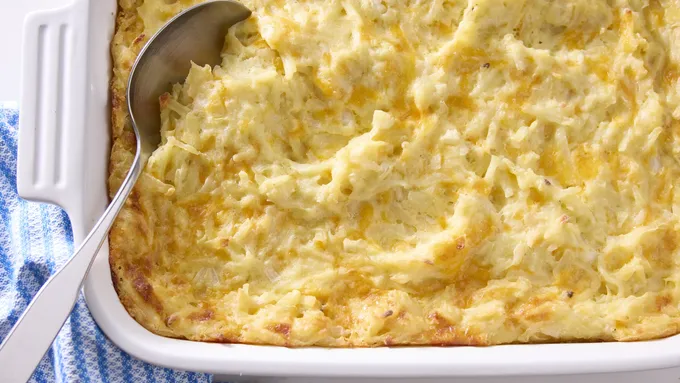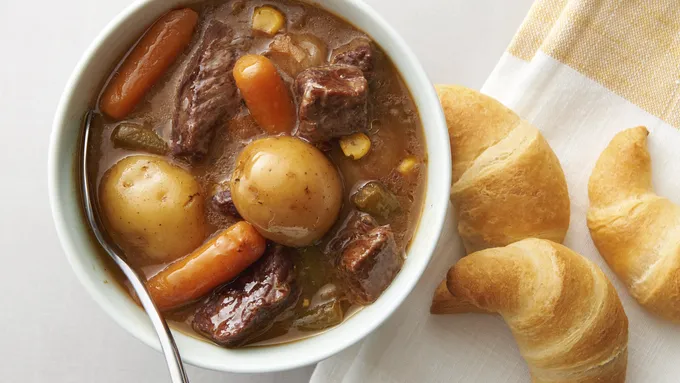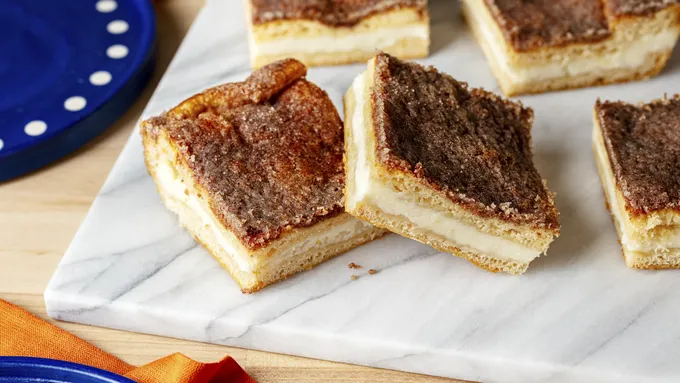How To Choose a Butternut Squash?
To make this butternut squash recipe, you want to start with the best butternut squash possible – it is the star of this side dish show, after all! Be sure to choose one that has a uniform, creamy-tan color (the darker, the better) and is firm to the touch. It should also be free of any bruises, cuts or soft spots. Also, check to see that it has a matte finish; if it’s shiny, that means the squash was picked too early and likely won’t be at its peak flavor and texture.
Finally, be sure to use the scale in your grocery store’s produce section to weigh your squash for the right proportions. For this recipe, we recommend a three-pound squash, which yields approximately 8 cups cubed. When preparing a butternut squash side dish, a good rule of thumb is 1/4 lb per person.
How to Make Roasted Butternut Squash
Don’t be intimidated by the idea of baked butternut squash—once you give it a try, you might find yourself drawn to the squash section of the grocery store time after time.
So, how do you make this wow-worthy dish? For the full details, head to the recipe instructions below, but here’s the gist of this easy recipe:
Prep the Squash
You’ll want to start by prepping the squash itself. First, peel off the squash skin with a vegetable peeler. Then, use a sharp knife to cut off the stem and the base of the squash. Cut the squash in half lengthwise, then use a spoon to scoop out the seeds and pulp. Cut each half into 1-inch cubes. Now, you’re ready to roast!
Toss with Seasonings
Arrange the cubed squash on a foil-lined baking sheet that’s been sprayed with cooking spray (the foil makes for easy cleanup, and the cooking spray ensures the squash won’t stick to the foil). Toss the squash with olive oil, salt, pepper and finely chopped fresh sage leaves . That’s it!
Bake
Place the baking sheet in the center of the oven and bake for about 30 to 35 minutes, or until the squash is soft and lightly golden. You’ll know the squash is done if you can poke it with a fork or a knife and it is tender.
Serve
Toss the warm roasted butternut squash with crisp, cooked bacon, transfer to your favorite serving dish, top with more fresh sage leaves, and enjoy.
Looking for the perfect main for this stellar side dish? Check out our Thanksgiving Roasted Turkey or any of our Foolproof Roast Recipes.
How to Make Perfect Bacon
The secret to ultimate flavor in this butternut squash recipe? The bacon! For this recipe, the bacon is cooked separately and tossed with the roasted butternut squash just before serving. This method ensures the bacon and squash both cook through completely, and you don’t run the risk of burning the bacon as you cook the squash.
There are many ways to make perfect bacon, but here are our two favorite methods:
Low and Slow in a Pan: Arrange bacon strips in a cold skillet. Make sure the strips don’t overlap. Cook the bacon over medium heat, using tongs to flip once the bacon lifts off the pan easily. Continue to cook until the bacon is brown, crisp and no longer translucent, then transfer to a paper towel-lined plate to drain and cool. Once fully cooled, chop the bacon with a knife or crumble with your fingers.
Bake it in the Oven: For less mess and effort, we recommend baking the bacon at 400°F for 20 to 25 minutes for crispy bacon. Line a rimmed baking sheet (one that’s deep enough to hold drippings) with foil, then place a wire baking rack on the foil. Place bacon strips in a single layer on the rack. Bake until brown and crisp, then use tongs to transfer bacon to a paper towel-lined plate to drain and cool. Once fully cooled, chop the bacon with a knife or crumble with your fingers.
How To Store Roasted Butternut Squash with Sage and Bacon
We’d be surprised if you had any leftover squash at your holiday table when you serve this dish, but if you do, here’s the best way to store it:
In the Fridge: Store leftover roasted butternut squash, fully cooled, in an airtight container in the fridge for up to 3 days.
In the Freezer: To keep the flavor and texture of the roasted squash, we do not recommend freezing leftovers once baked. However, if you bought an extra-large butternut squash and want to freeze the extra raw squash, you can peel and cut it into cubes, then arrange in a single layer on a rimmed baking sheet lined with foil. Freeze the squash for at least 1 hour, then transfer to a resealable food-storage bag. Freeze for up to 10 months.
How to Freeze Fresh Sage: If you have extra fresh sage leaves, you can freeze them! Simply remove the leaves from the stems and place the sage in a resealable food-storage bag. Freeze for up to 1 year.
Frequently Asked Questions
What Kind of Bacon Should I Use?
One great aspect of this recipe is that all bacon is welcome! You can use whatever flavor or type of bacon you prefer for this recipe, as long as it’s cooked and crumbled. We are partial to maple bacon or hickory-smoked bacon for a flavorful autumn side dish, but you can also any of the following for your own twist on this recipe:
Thick-cut, classic-cut or center-cut
Smoked (applewood, hardwood or hickory)
Sweet (maple)
Organic (uncured or no-sugar)
Turkey (for a healthier option!)
Be aware that, depending on the type of bacon you choose to use for this recipe, cook times may vary. For example, if you’re using thick-cut bacon, you might need to cook the bacon for longer than you would if you choose to use classic-cut bacon to get the same level of crispness.
We do not recommend using pre-cooked bacon bits for this recipe, as they don’t provide the same level of flavor or crisp texture that really makes this recipe shine.
Why is my Squash Sticking to the Pan
Root vegetables can stick to the pan if they aren’t greased well enough.
Line your baking pan with foil or parchment paper and spray the foil or paper with cooking spray to keep the veggies from sticking to the pan as they bake.
Lining your baking pans with foil or parchment paper is key because the natural sugars and lack of fat in vegetables will sometimes cause them to stick to surfaces as they bake.
Lining your pans also makes cleanup a breeze! Once the food is done cooking, you can remove it from the pan, crumple up the foil or parchment paper, throw it away, and you’re done—no extra cleaning of the pan necessary.
(function() {
document.addEventListener('DOMContentLoaded', function() {
var componentMetadata = JSON.parse('\x7b\x22componentName\x22\x3a\x22RecipeFAQ_e8af84a8-5198-47ca-bc1c-daf22247ecf7\x22,\x22deferOptions\x22\x3a\x7b\x22deferComponent\x22\x3afalse,\x22deferType\x22\x3a\x22None\x22,\x22deferId\x22\x3a\x22r24e4227a77ff49df8d4bab9a2fc24201\x22,\x22deferredContainerId\x22\x3a\x22\x2fmain\x2frdpFAQ\x22,\x22deferredContainerView\x22\x3anull\x7d,\x22viewName\x22\x3a\x22RecipeFAQ\x22\x7d');
var configuration = {"title":"Roasted Butternut Squash with Bacon and Sage","introduction":"The turkey may be the main dish of the holiday menu (and of course, we can’t forget the Pillsbury™ crescent rolls, or dessert!), but when it comes to side dishes, that’s when you can really wow everyone at the table. Whether you’re planning a meal for your annual Friendsgiving gathering, Thanksgiving holiday, or even a special weekend dinner for your family, let the flavors of fall come to life with this easy and delicious Roasted Butternut Squash with Bacon and Sage recipe.\u003c/p\u003e\n\u003cp\u003eWith fresh sage, crisp bacon, and tender butternut squash in every comforting bite, this showstopping side dish celebrates the seasonal ingredients of autumn with minimal effort. Why sage and bacon? When combined with the nutty, lightly sweet taste of butternut squash, the earthy aroma of fresh sage, and salty richness of cooked bacon sing all the praises of fall flavors. It even looks pretty, with all the autumnal colors of orange, brown and green (but not too pretty to eat, of course).\u003c/p\u003e\n\u003cp\u003eIf you’ve never had butternut squash before, let this recipe be your first dive into the world of squash, where you’ll be greeted with warm, aromatic flavors and hearty textures with the help of just a few ingredients. Once you give it a try, you’ll understand why squash isn’t just meant for the sidelines—it can certainly stand up as part of the show. And when you serve it with other sides or mains, it will make the whole menu complete.\u003c/p\u003e\n\u003cp\u003eStart by choosing the perfect butternut squash for your recipe, and the rest falls into place with ease, so you can spend more time with those you love and less time in the kitchen. You may find that this side dish becomes a regular part of your meals all autumn long!\u003c/p\u003e","servingSize":"1/2 Cup","image":{"small":{"media":"(min-width: 0px)","src":"https://mojo.generalmills.com/api/public/content/W6-Ceh2IRqGu1tAOOOzsog_webp_base.webp?v=15f45fe9\u0026t=e724eca7b3c24a8aaa6e089ed9e611fd"},"medium":{"media":"(min-width: 500px)","src":"https://mojo.generalmills.com/api/public/content/W6-Ceh2IRqGu1tAOOOzsog_webp_base.webp?v=15f45fe9\u0026t=191ddcab8d1c415fa10fa00a14351227"},"large":{"media":"(min-width: 767px)","src":"https://mojo.generalmills.com/api/public/content/W6-Ceh2IRqGu1tAOOOzsog_webp_base.webp?v=15f45fe9\u0026t=191ddcab8d1c415fa10fa00a14351227"},"alt":"Roasted Butternut Squash with Bacon and Sage"},"contributor":{"label":"By","name":"Pillsbury Kitchens","profileUrl":"/about-us","displayDate":{"label":"Updated","date":"Jun 26, 2024"}},"ingredientGroups":[{"ingredients":[{"quantity":"3","description":"lb butternut squash"},{"quantity":"2","description":"tablespoons olive oil"},{"quantity":"1","description":"teaspoon salt"},{"quantity":"1/4","description":"teaspoon pepper"},{"quantity":"2","description":"tablespoons plus 1 teaspoon finely chopped fresh sage leaves"},{"quantity":"1/4","description":"cup cooked and crumbled bacon (4 slices)"}]}],"steps":[{"description":"Heat oven to 400°F. Line large rimmed baking sheet with foil. Spray with cooking spray."},{"description":"Peel and cut squash into 1-inch cubes.","stepShotImageUrl":"//mojo.generalmills.com/api/public/content/H4VjGaCuQmKrGEOJ8LLPfA_webp_base.webp?v=8b9f3258\u0026t=51a43a57af4046789e5a7f20567b1195"},{"description":"Arrange squash in single layer on baking sheet. Drizzle olive oil over squash, then top with salt, pepper and 2 tablespoons of the fresh sage; toss to combine.","stepShotImageUrl":"//mojo.generalmills.com/api/public/content/-W4DwQmzR22mK8B_j01W6w_webp_base.webp?v=55ff7989\u0026t=51a43a57af4046789e5a7f20567b1195"},{"description":"Bake 30 to 35 minutes or until squash is soft and lightly golden. Toss squash with bacon; spoon into serving dish. Top with remaining 1 teaspoon fresh sage; serve warm.","stepShotImageUrl":"//mojo.generalmills.com/api/public/content/RzGzeKYEROqrA1RO50seiQ_webp_base.webp?v=e308f530\u0026t=51a43a57af4046789e5a7f20567b1195"}],"tips":[{"title":"","description":"Impress with the flavors of fall! Roasted Butternut Squash with Bacon and Sage is a simple and savory side dish bursting with notes of autumn.","category":"Rich Snippet","tipShots":[]},{"title":"","description":"Use a metal spoon to easily scoop out seeds from butternut squash.","category":"Method Note","tipShots":[]},{"title":"","description":"Serve with Pillsbury™ Crescent Rolls for the perfect pairing.","category":"Serving Suggestions/Menu","tipShots":[]},{"title":"","description":"Looking for a similar side dish that’s a little lighter? Swap the squash for \u003ca href=\u0022https://www.pillsbury.com/recipes/roasted-brussels-sprouts-with-bacon/43a696ca-7edb-4bfa-aa4f-0e97a8e85294/\u0022\u003eRoasted Brussels Sprouts with Bacon\u003c/a\u003e to get some flavorful veggies on the table.","category":"No Title","tipShots":[]},{"title":"","description":"For added flavor, add a teaspoon of bacon drippings to the olive oil when greasing the squash.","category":"No Title","tipShots":[]},{"title":"","description":"Kitchen Tested: 5/2024","category":"Kitchen Tested","tipShots":[]}],"kitchenTips":[{"title":"","description":"Use a metal spoon to easily scoop out seeds from butternut squash.","category":"Method Note","tipShots":[]},{"title":"","description":"Serve with Pillsbury™ Crescent Rolls for the perfect pairing.","category":"Serving Suggestions/Menu","tipShots":[]},{"title":"","description":"Looking for a similar side dish that’s a little lighter? Swap the squash for \u003ca href=\u0022https://www.pillsbury.com/recipes/roasted-brussels-sprouts-with-bacon/43a696ca-7edb-4bfa-aa4f-0e97a8e85294/\u0022\u003eRoasted Brussels Sprouts with Bacon\u003c/a\u003e to get some flavorful veggies on the table.","category":"No Title","tipShots":[]},{"title":"","description":"For added flavor, add a teaspoon of bacon drippings to the olive oil when greasing the squash.","category":"No Title","tipShots":[]}],"additionalContent":[{"title":"How To Choose a Butternut Squash?","description":"To make this butternut squash recipe, you want to start with the best butternut squash possible – it is the star of this side dish show, after all! Be sure to choose one that has a uniform, creamy-tan color (the darker, the better) and is firm to the touch. It should also be free of any bruises, cuts or soft spots. Also, check to see that it has a matte finish; if it’s shiny, that means the squash was picked too early and likely won’t be at its peak flavor and texture.\u003c/p\u003e \n\u003cp\u003eFinally, be sure to use the scale in your grocery store’s produce section to weigh your squash for the right proportions. For this recipe, we recommend a three-pound squash, which yields approximately 8 cups cubed. When preparing a butternut squash side dish, a good rule of thumb is 1/4 lb per person.\u003c/p\u003e","category":"SEO Content_1","tipShots":[]},{"title":"How to Make Roasted Butternut Squash","description":"Don’t be intimidated by the idea of baked butternut squash—once you give it a try, you might find yourself drawn to the squash section of the grocery store time after time.\u003c/p\u003e \n\u003cp\u003eSo, how do you make this wow-worthy dish? For the full details, head to the recipe instructions below, but here’s the gist of this easy recipe:\u003c/p\u003e\n\u003ch3\u003e\u003cb\u003ePrep the Squash\u003c/b\u003e\u003c/h3\u003e\n\u003cp\u003eYou’ll want to start by prepping the squash itself. First, peel off the squash skin with a vegetable peeler. Then, use a sharp knife to cut off the stem and the base of the squash. Cut the squash in half lengthwise, then use a spoon to scoop out the seeds and pulp. Cut each half into 1-inch cubes. Now, you’re ready to roast!\u003c/p\u003e\n\u003ch3\u003e\u003cb\u003eToss with Seasonings\u003c/b\u003e\u003c/h3\u003e\n\u003cp\u003eArrange the cubed squash on a foil-lined baking sheet that’s been sprayed with cooking spray (the foil makes for easy cleanup, and the cooking spray ensures the squash won’t stick to the foil). Toss the squash with olive oil, salt, pepper and finely chopped fresh sage leaves . That’s it!\u003c/p\u003e\n\u003ch3\u003e\u003cb\u003eBake\u003c/b\u003e\u003c/h3\u003e\n\u003cp\u003ePlace the baking sheet in the center of the oven and bake for about 30 to 35 minutes, or until the squash is soft and lightly golden. You’ll know the squash is done if you can poke it with a fork or a knife and it is tender.\u003c/p\u003e\n\u003ch3\u003e\u003cb\u003eServe\u003c/b\u003e\u003c/h3\u003e\n\u003cp\u003eToss the warm roasted butternut squash with crisp, cooked bacon, transfer to your favorite serving dish, top with more fresh sage leaves, and enjoy.\u003c/p\u003e\n\u003cp\u003eLooking for the perfect main for this stellar side dish? Check out our \u003ca href=\u0022https://www.pillsbury.com/recipes/best-roast-turkey/52b257a5-1ca7-44fc-bdc8-cbed3d1c9489/\u0022\u003eThanksgiving Roasted Turkey\u003c/a\u003e or any of our \u003ca href=\u0022https://www.pillsbury.com/holidays-celebrations/christmas/6-roast-beasts-for-your-holiday-feast/\u0022\u003eFoolproof Roast Recipes\u003c/a\u003e.\u003c/p\u003e","category":"SEO Content_2","tipShots":[]},{"title":"How to Make Perfect Bacon","description":"The secret to ultimate flavor in this butternut squash recipe? The bacon! For this recipe, the bacon is cooked separately and tossed with the roasted butternut squash just before serving. This method ensures the bacon and squash both cook through completely, and you don’t run the risk of burning the bacon as you cook the squash.\u003c/p\u003e \n\u003cp\u003eThere are many ways to make perfect bacon, but here are our two favorite methods:\u003c/p\u003e\n\u003cp\u003e\u003cb\u003eLow and Slow in a Pan:\u003c/b\u003e Arrange bacon strips in a cold skillet. Make sure the strips don’t overlap. Cook the bacon over medium heat, using tongs to flip once the bacon lifts off the pan easily. Continue to cook until the bacon is brown, crisp and no longer translucent, then transfer to a paper towel-lined plate to drain and cool. Once fully cooled, chop the bacon with a knife or crumble with your fingers.\u003c/p\u003e\n\u003cp\u003e\u003cb\u003eBake it in the Oven:\u003c/b\u003e For less mess and effort, we recommend baking the bacon at 400°F for 20 to 25 minutes for crispy bacon. Line a rimmed baking sheet (one that’s deep enough to hold drippings) with foil, then place a wire baking rack on the foil. Place bacon strips in a single layer on the rack. Bake until brown and crisp, then use tongs to transfer bacon to a paper towel-lined plate to drain and cool. Once fully cooled, chop the bacon with a knife or crumble with your fingers.\u003c/p\u003e","category":"SEO Content_3","tipShots":[]},{"title":"How To Store Roasted Butternut Squash with Sage and Bacon","description":"We’d be surprised if you had any leftover squash at your holiday table when you serve this dish, but if you do, here’s the best way to store it:\u003c/p\u003e\n\u003cp\u003e\u003cb\u003eIn the Fridge:\u003c/b\u003e Store leftover roasted butternut squash, fully cooled, in an airtight container in the fridge for up to 3 days.\u003c/p\u003e\n\u003cp\u003e\u003cb\u003eIn the Freezer:\u003c/b\u003e To keep the flavor and texture of the roasted squash, we do not recommend freezing leftovers once baked. However, if you bought an extra-large butternut squash and want to freeze the extra raw squash, you can peel and cut it into cubes, then arrange in a single layer on a rimmed baking sheet lined with foil. Freeze the squash for at least 1 hour, then transfer to a resealable food-storage bag. Freeze for up to 10 months.\u003c/p\u003e \n\u003cp\u003e\u003cb\u003eHow to Freeze Fresh Sage:\u003c/b\u003e If you have extra fresh sage leaves, you can freeze them! Simply remove the leaves from the stems and place the sage in a resealable food-storage bag. Freeze for up to 1 year.\u003c/p\u003e","category":"SEO Content_4","tipShots":[]}],"faq":[{"title":"What Kind of Bacon Should I Use?","description":"One great aspect of this recipe is that all bacon is welcome! You can use whatever flavor or type of bacon you prefer for this recipe, as long as it’s cooked and crumbled. We are partial to maple bacon or hickory-smoked bacon for a flavorful autumn side dish, but you can also any of the following for your own twist on this recipe:\u003c/p\u003e\n\u003cp\u003eThick-cut, classic-cut or center-cut\u003c/p\u003e\n\u003cp\u003eSmoked (applewood, hardwood or hickory)\u003c/p\u003e\n\u003cp\u003eSweet (maple)\u003c/p\u003e\n\u003cp\u003eOrganic (uncured or no-sugar)\u003c/p\u003e\n\u003cp\u003eTurkey (for a healthier option!)\u003c/p\u003e\n\u003cp\u003eBe aware that, depending on the type of bacon you choose to use for this recipe, cook times may vary. For example, if you’re using thick-cut bacon, you might need to cook the bacon for longer than you would if you choose to use classic-cut bacon to get the same level of crispness.\u003c/p\u003e \n\u003cp\u003eWe do not recommend using pre-cooked bacon bits for this recipe, as they don’t provide the same level of flavor or crisp texture that really makes this recipe shine.\u003c/p\u003e","category":"FAQ_1","tipShots":[]},{"title":"Why is my Squash Sticking to the Pan","description":"Root vegetables can stick to the pan if they aren’t greased well enough.\u003c/p\u003e\n\u003cp\u003eLine your baking pan with foil or parchment paper and spray the foil or paper with cooking spray to keep the veggies from sticking to the pan as they bake.\u003c/p\u003e \n\u003cp\u003eLining your baking pans with foil or parchment paper is key because the natural sugars and lack of fat in vegetables will sometimes cause them to stick to surfaces as they bake.\u003c/p\u003e \n\u003cp\u003eLining your pans also makes cleanup a breeze! Once the food is done cooking, you can remove it from the pan, crumple up the foil or parchment paper, throw it away, and you’re done—no extra cleaning of the pan necessary.\u003c/p\u003e","category":"FAQ_2","tipShots":[]}],"tipCategories":[{"categoryName":"Kitchen Tested","heading":"More About This Recipe","cssClass":"recipePartStory","expandOnInit":false,"expandText":"More +","collapseText":"Less -","expandEventName":"","collapseEventName":"","image":"","tips":[{"title":"","description":"Kitchen Tested: 5/2024","category":"Kitchen Tested","tipShots":[]}],"isExpandable":false},{"categoryName":"Method Note","heading":"","cssClass":"recipePartMethodNote","expandOnInit":false,"expandText":"More +","collapseText":"Less -","expandEventName":"","collapseEventName":"","image":"","tips":[{"title":"","description":"Use a metal spoon to easily scoop out seeds from butternut squash.","category":"Method Note","tipShots":[]}],"isExpandable":false},{"categoryName":"Rich Snippet","heading":"","cssClass":"recipePartMethodNote","expandOnInit":false,"expandText":"More +","collapseText":"Less -","expandEventName":"","collapseEventName":"","image":"","tips":[{"title":"","description":"Impress with the flavors of fall! Roasted Butternut Squash with Bacon and Sage is a simple and savory side dish bursting with notes of autumn.","category":"Rich Snippet","tipShots":[]}],"isExpandable":false}],"nutritionInfo":{"configuration":{"showAsTable":false,"noNutritionInformationAvailableMessage":"No nutrition information available for this recipe","poweredByText":"\u003cp\u003eNutrition information for this recipe is estimated using a leading nutrition calculation application, but is an estimate only. Actual nutrition values will vary based on the exact ingredients or brands you may use.\u003c/p\u003e\n\u003ca href=\u0022http://developer.edamam.com\u0022\u003ePowered By \u003cimg src=\u0022-/media/C4F33FD467AB4A3AB59AAC4F6306AB04.ashx\u0022 alt=\u0022Edamam\u0022 /\u003e\u003c/a\u003e","nutritionChartTitle":"Nutrition Facts","nutritionInformationLabel":"Nutrition","servingSizeText":"Serving Size:","dailyValuesDisclaimer":"*Percent Daily Values are based on a 2,000 calorie diet.","percentDailyValueText":"% Daily Value","percentDailyValueFooterTitleText":"% Daily Value*:","exchangeInformationTitleText":"Exchanges:","nutritionFactsExpandText":"More Nutrition","nutritionFactsCollapseText":"Less Nutrition"},"facts":{"carbohydrateChoice":{"amountPercent":"","amountUnits":"1","title":"Carbohydrate Choice"},"vitaminA":{"amountPercent":"260%","amountUnits":"260%","title":"Vitamin A"},"vitaminC":{"amountPercent":"15%","amountUnits":"15%","title":"Vitamin C"},"calcium":{"amountPercent":"6%","amountUnits":"6%","title":"Calcium"},"iron":{"amountPercent":"4%","amountUnits":"4%","title":"Iron"},"protein":{"amountPercent":"","amountUnits":"2g","title":"Protein"},"dietaryFiber":{"amountPercent":"15%","amountUnits":"4g","title":"Dietary Fiber"},"sugars":{"amountPercent":"","amountUnits":"2g","title":"Sugars"},"totalCarbohydrate":{"amountPercent":"4%","amountUnits":"13g","title":"Total Carbohydrate"},"sodium":{"amountPercent":"12%","amountUnits":"290mg","title":"Sodium"},"potassium":{"amountPercent":"10%","amountUnits":"350mg","title":"Potassium"},"cholesterol":{"amountPercent":"0%","amountUnits":"0mg","title":"Cholesterol"},"transFat":{"amountPercent":"","amountUnits":"0g","title":"Trans Fat"},"saturatedFat":{"amountPercent":"4%","amountUnits":"1g","title":"Saturated Fat"},"totalFat":{"amountPercent":"6%","amountUnits":"4g","title":"Total Fat"},"caloriesFromFat":{"amountPercent":"","amountUnits":"35","title":"Calories from Fat"},"calories":{"amountPercent":"","amountUnits":"90","title":"Calories"}},"servingSize":"1/2 Cup","exchangeInfo":"0 Starch; 0 Fruit; 1/2 Other Carbohydrate; 0 Skim Milk; 0 Low-Fat Milk; 0 Milk; 1 Vegetable; 0 Very Lean Meat; 0 Lean Meat; 0 High-Fat Meat; 1 Fat;","showPoweredBy":false,"showRecipeTotalTime":true,"showRecipePrepTime":true,"showCarbohydrateChoices":true},"trademarks":[],"labels":{"ingredientsHeader":"Ingredients","stepsHeader":"Instructions","stepsImageHideText":"Hide Images","stepsImageShowText":"Show Images","stepNumberText":"Step","faqHeader":"Frequently Asked Questions","tipsHeader":"\u003cp class=\u0022textFirst\u0022\u003eRecipe Tips\u003c/p\u003e","tipItemHeadingFormat":"tip {0}","postedBy":"By","copyright":"© {yyyy} ®/TM General Mills All Rights Reserved","showDrawerText":"Show","hideDrawerText":"Hide","expandDescriptionText":"More +","collapseDescriptionText":"Less -","ariaLiveLabelFormat":"Showing {0} through {1} of {2}","scrollLeftButtonLabel":"Scroll Left","scrollRightButtonLabel":"Scroll Right","includeScrollIndicator":false},"primaryAttributes":[{"label":"Prep Time","values":[{"text":"25","label":"min"}]},{"label":"Total","values":[{"text":"55","label":"min"}]},{"label":"Ingredients","values":[{"text":"6"}]},{"label":"Servings","values":[{"text":"10"}]}],"secondaryAttributes":[],"badges":[{"badgeType":3,"badgeText":"","label":"Kitchen Tested","imageUrl":"/-/media/GMI/Core-Sites/PB/Images/Shared/RecipeParts/KitchenTested_PB1_new.jpg?sc_lang=en","linkUrl":"/about-us/kitchen-tested","metaDataTags":[],"showMemberInfo":false,"matchedMetadataId":"00000000-0000-0000-0000-000000000000"}],"backgroundImageUrl":"","breadcrumbs":{"links":[{"url":"/","label":"Home"},{"url":"/recipes","label":"Recipes"}],"currentPageName":"Roasted Butternut Squash with Bacon and Sage"}};
var moduleName = 'recipeFaq';
var isVueModule = true;
GeneralMills.PandoSites.RegisterControlInstance(moduleName, configuration, componentMetadata, isVueModule)
});
})();
![]()
![]()
![]()










